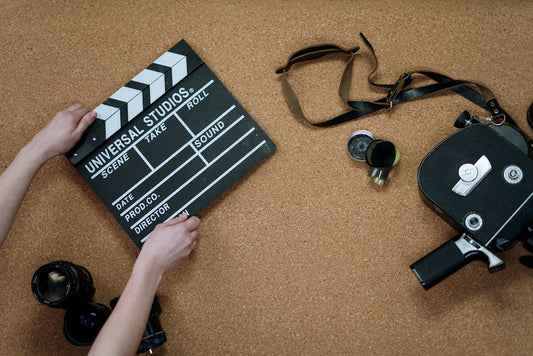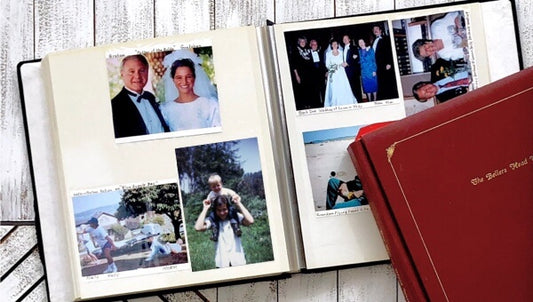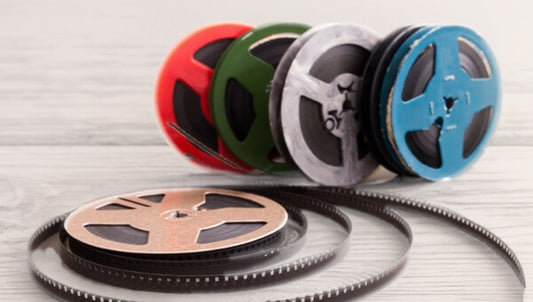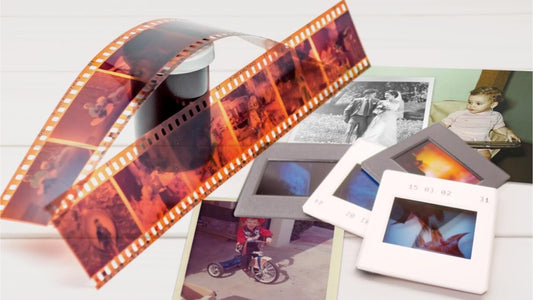From silent films to CGI-packed blockbusters, the film world has always been full of surprises. Every movie, from the tiniest indie to the biggest franchise, has a story behind the story. At Capture, we know how powerful old films and home movies can be - and we love looking at the big picture. Whether you lived through cinema’s golden age or grew up watching VHS tapes on repeat, these facts about movie history will give you a fresh appreciation for how far the industry has come.
Jump to:
What Are the Origins of Filmmaking?
It all started in the late 1800s. The earliest films were short, silent, and black-and-white. They were shot using hand-cranked cameras and played back on mechanical projectors. The first movie camera, called the Kinetograph, was developed by Thomas Edison and William Dickson. It recorded short films that viewers could watch through a machine called the Kinetoscope. These “films” were often just a few seconds long and featured simple subjects like people walking or sneezing.

Soon after, filmmakers started creating longer, more complex scenes. In 1895, the Lumière brothers debuted Workers Leaving the Lumière Factory, which is often credited as the first real public film screening. These early filmmaking facts show how quickly storytelling evolved - from simple clips of daily life to dramatic scenes and narratives. People were amazed by the idea of moving pictures and packed theaters to see them.
People also started experimenting with formats like 8mm and 16mm film for home use. Today, companies like Capture provide 8mm film to digital transfer services to help preserve these early pieces of visual history before they fade away. These formats became especially popular for capturing birthday parties, school plays, and family vacations.
5 Interesting Facts About Films
So, what are 5 interesting facts about the film industry? You might be surprised how strange and fun the film world can be. Here are five of our favorites:
- The longest movie ever made is over 85 hours long: it’s called Logistics, created by two Swedish filmmakers.
- The Hollywood sign originally said “Hollywoodland” when it was built in 1923 as a real estate ad.
- Psycho (1960) was the first American film to show a toilet flushing. Yes, really.
- Walt Disney holds the record for the most Oscars: 22 wins and 59 nominations!
- In the silent film era, actors had to wear blue lipstick because it looked better in black-and-white footage.
These aren’t just movie fun facts - they’re a peek into the creativity and quirks behind the scenes. Film production is full of surprises, from on-set accidents that became iconic scenes to costumes that cost more than cars. There’s always more than meets the eye when it comes to Hollywood history.
And while modern movies are packed with digital tools, many of the best scenes in history were done with simple tricks and creative camera work.

Interesting Facts About Cinema History
What are some interesting facts about cinema history? There’s no shortage of standout moments that shaped the silver screen. Even small changes had big ripple effects. For example, the invention of color grading allowed filmmakers to create emotion with just a color tone.
- The first feature-length film ever made was The Story of the Kelly Gang (1906) in Australia.
- The first “talkie” (a film with synchronized dialogue) was The Jazz Singer in 1927.
- Color films were introduced in the early 1900s, but they didn’t fully take over until The Wizard of Oz and Gone with the Wind in 1939.
Here’s a short list of more film trivia that still fascinates film lovers:
- Charlie Chaplin once entered a Chaplin look-alike contest - and lost.
- The original voice of Mickey Mouse was Walt Disney himself.
- Alfred Hitchcock never won an Oscar for Best Director, despite being one of cinema’s legends.
Many early movies have been lost due to decay, fire, or neglect. That’s why film preservation matters so much today. If you’ve got reels collecting dust, 16mm film to digital conversions can give them a second life before they’re gone for good.
The Evolution of Special Effects & CGI
Today’s special effects are jaw-dropping, but they came a long way from humble beginnings. In the early days, filmmakers used practical effects, think fake miniatures, stop-motion animation, and painted backdrops. Georges Méliès, a magician turned director, was one of the first to use special effects on film in A Trip to the Moon (1902). His work involved jump cuts, hidden wires, and double exposures that amazed audiences at the time.
The real shift came in the late 20th century:
- Star Wars (1977) brought in motion-controlled cameras.
- Tron (1982) was one of the first films to use computer-generated imagery.
- Jurassic Park (1993) combined CGI with animatronics, changing the industry forever.
Nowadays, entire worlds are created on a green screen. Animation and motion capture blend seamlessly into live-action. But even the best CGI can’t replace the charm of analog memories. A VHS video conversion service can help preserve your old home movie tapes filled with effects - no matter how cheesy - for future generations. From claymation monsters to awkward alien suits, those visuals still hold nostalgic value.

There are also plenty of weird movie facts connected to CGI. For example, in Toy Story, the animators had to animate every single blink and breath frame by frame because automated tools didn’t exist yet. That level of detail helped Pixar change animation forever.
Why These Facts About Movie History Still Matter Today
From hand-cranked cameras to fully digital blockbusters, the journey of cinema is packed with fascinating stories. These facts about movie history remind us how much the industry has changed, and how much it continues to surprise us. From the golden age of Hollywood to the digital streaming era, films continue to inspire, entertain, and bring people together. Whether you're rewatching an old favorite or discovering a classic for the first time, the magic of movies lives on. And thanks to Capture, your personal film history - no matter the format - can be preserved and enjoyed for years to come.










